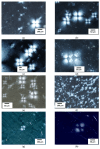Features of the Structure of Layered Epoxy Composite Coatings Formed on a Metal-Ceramic-Coated Aluminum Base
- PMID: 40805498
- PMCID: PMC12348820
- DOI: 10.3390/ma18153620
Features of the Structure of Layered Epoxy Composite Coatings Formed on a Metal-Ceramic-Coated Aluminum Base
Abstract
Difficult, extreme operating conditions of parabolic antennas under precipitation and sub-zero temperatures require the creation of effective heating systems. The purpose of the research is to develop a multilayer coating containing two metal-ceramic layers, epoxy composite layers, carbon fabric, and an outer layer of basalt fabric, which allows for effective heating of the antenna, and to study the properties of this coating. The multilayer coating was formed on an aluminum base that was subjected to abrasive jet processing. The first and second metal-ceramic layers, Al2O3 + 5% Al, which were applied by high-speed multi-chamber cumulative detonation spraying (CDS), respectively, provide maximum adhesion strength to the aluminum base and high adhesion strength to the third layer of the epoxy composite containing Al2O3. On this not-yet-polymerized layer of epoxy composite containing Al2O3, a layer of carbon fabric (impregnated with epoxy resin) was formed, which serves as a resistive heating element. On top of this carbon fabric, a layer of epoxy composite containing Cr2O3 and SiO2 was applied. Next, basalt fabric was applied to this still-not-yet-polymerized layer. Then, the resulting layered coating was compacted and dried. To study this multilayer coating, X-ray analysis, light and raster scanning microscopy, and transmission electron microscopy were used. The thickness of the coating layers and microhardness were measured on transverse microsections. The adhesion strength of the metal-ceramic coating layers to the aluminum base was determined by both bending testing and peeling using the adhesive method. It was established that CDS provides the formation of metal-ceramic layers with a maximum fraction of lamellae and a microhardness of 7900-10,520 MPa. In these metal-ceramic layers, a dispersed subgrain structure, a uniform distribution of nanoparticles, and a gradient-free level of dislocation density are observed. Such a structure prevents the formation of local concentrators of internal stresses, thereby increasing the level of dispersion and substructural strengthening of the metal-ceramic layers' material. The formation of materials with a nanostructure increases their strength and crack resistance. The effectiveness of using aluminum, chromium, and silicon oxides as nanofillers in epoxy composite layers was demonstrated. The presence of structures near the surface of these nanofillers, which differ from the properties of the epoxy matrix in the coating, was established. Such zones, specifically the outer surface layers (OSL), significantly affect the properties of the epoxy composite. The results of industrial tests showed the high performance of the multilayer coating during antenna heating.
Keywords: cumulative detonation spraying; dislocation density; epoxy composites; hardening; microstructure; multilayer coatings; nanoparticles; oxide coating layer; subgrain structure; temperature.
Conflict of interest statement
The authors declare no conflicts of interest.
Figures











Similar articles
-
Prescription of Controlled Substances: Benefits and Risks.2025 Jul 6. In: StatPearls [Internet]. Treasure Island (FL): StatPearls Publishing; 2025 Jan–. 2025 Jul 6. In: StatPearls [Internet]. Treasure Island (FL): StatPearls Publishing; 2025 Jan–. PMID: 30726003 Free Books & Documents.
-
Electrophoresis.2025 Jul 14. In: StatPearls [Internet]. Treasure Island (FL): StatPearls Publishing; 2025 Jan–. 2025 Jul 14. In: StatPearls [Internet]. Treasure Island (FL): StatPearls Publishing; 2025 Jan–. PMID: 36251838 Free Books & Documents.
-
Signs and symptoms to determine if a patient presenting in primary care or hospital outpatient settings has COVID-19.Cochrane Database Syst Rev. 2022 May 20;5(5):CD013665. doi: 10.1002/14651858.CD013665.pub3. Cochrane Database Syst Rev. 2022. PMID: 35593186 Free PMC article.
-
Effect of Different Concentrations of Nano Hydroxyapatite on the Microshear Bond Strength of Zirconia to Resin Cement.Int J Prosthodont. 2025 Jun 20;0(0):1-21. doi: 10.11607/ijp.9205. Online ahead of print. Int J Prosthodont. 2025. PMID: 40540639
-
Which mechanical and physical testing methods are relevant for predicting the clinical performance of ceramic-based dental prostheses?Clin Oral Implants Res. 2007 Jun;18 Suppl 3:218-31. doi: 10.1111/j.1600-0501.2007.01460.x. Clin Oral Implants Res. 2007. PMID: 17594384
References
-
- Gamboa-Soto F., Bautista-García R., Llanes-Gil López D.I., Berme J.E., Tinoco Mendiola R., Olive-Méndez S.F., González-Hernández A. Heat Treatment-Driven Structural and Morphological Transformation under Non-Parametric Tests on Metal–Ceramic-Sputtered Coatings. Ceramics. 2025;8:25. doi: 10.3390/ceramics8010025. - DOI
-
- Imbirovych N., Povstyanoy O., Zaleta O., Shymchuk S., Priadko O. The Influence of Synthesis Regimes on Operational Properties of Oxide Ceramic Coatings on an Aluminum Alloy. In: Ivanov V., Trojanowska J., Pavlenko I., Zajac J., Peraković D., editors. Advances in Design, Simulation and Manufacturing, Proceedings of the 4th International Conference on Design, Simulation, Manufacturing: The Innovation Exchange, DSMIE 2021, Lviv, Ukraine, 8–11 June 2021. Springer Science and Business Media GmbH; Cham, Switzerland: 2021. pp. 536–545. Lecture Notes in Mechanical Engineering. - DOI
-
- Baranovska O.V., Bagliuk G.A., Buketov A.V., Sapronov O.O., Baranovskyi D.I. The Influence of the Dispersed Filler of the Ni–Fe–Si–C System on the Physicomechanical Properties and Structure of Epoxy Composites. Mater. Sci. 2024;59:608–615. doi: 10.1007/s11003-024-00817-3. - DOI
-
- Buketov A.V., Bagliuk G.A., Sizonenko O.M., Sapronov O.O., Smetankin S.O., Torpakov A.S. Effect of Particulate Ti–Al–TiC Reinforcements on the Mechanical Properties of Epoxy Polymer Composites. Powder Metall. Met. Ceram. 2023;61:586–596. doi: 10.1007/s11106-023-00347-8. - DOI
-
- Baglyuk G.A., Baranovska O.V., Buketov A.V., Sapronov O.O., Smetankin S.O., Bykov O.M., Baranovskyi D.I. Physicomechanical Properties and Structure of Multicomponent Titanium-Matrix-Base Alloy Dispersion Epoxy Composites. Strength Mater. 2023;55:534–543. doi: 10.1007/s11223-023-00546-z. - DOI
Grants and funding
LinkOut - more resources
Full Text Sources

